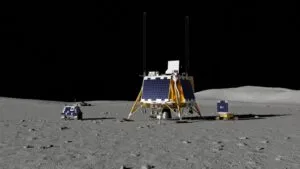It is a NASA Commercial Lunar Payload Services (CLPS) contract.
The mission will use Firefly’s Elytra orbital vehicle and Blue Ghost lunar lander. Together they will enable payload operations that include evaluating the Moon’s south pole resources, such as hydrogen, water, and other minerals, and studying the radiation and thermal environment.
These will affect future astronauts and lunar infrastructure development, highlights the company.
“Firefly is honored to support another NASA CLPS task order as a proven, reliable partner for robotic missions to the Moon,” said Jason Kim, CEO of Firefly Aerospace. “Following our first Blue Ghost mission that made history just a few months ago, this bold Firefly team proved we have the right mix of grit, innovation, and dedication to not only stick the landing, but also complete all scientific objectives for our payload partners.”
“We’ve set the bar high, and we aim to continue setting new records in our missions to come with our active production line of Blue Ghost landers.”
Operations
What are the Blue Ghost Mission 4 operations? Firefly’s Elytra Dark transfer vehicle will first deploy the Blue Ghost lander into lunar orbit. It will then remain on orbit to provide a long-haul communications relay for the mission.
For its part, Blue Ghost will then land in the Moon’s south pole region. It will then deploy the rovers, and enable payloads operations with data, power, and communications services. It will be operating for more than 12 days on the lunar surface.
Blue Ghost payloads
The NASA-sponsored payloads onboard Blue Ghost include two rovers: the MoonRanger rover and a Canadian Space Agency rover.
Also on board will be a Laser Ablation Ionization Mass Spectrometer (LIMS), a Laser Retroreflector Array (LRA), and the Stereo Cameras for Lunar Plume Surface Studies (SCALPSS), which also flew on Blue Ghost Mission 1.
The aim is these payloads will help uncover the composition and resources available at the Moon’s south pole.
The mission will also advance lunar navigation, and help evaluate the chemical composition of lunar regolith. Finally, it will also study the effects of a lander’s plume on the Moon’s surface during landings.
Fourth mission
“As our Elytra constellation continues to grow in lunar orbit, Firefly is in a unique position to provide lunar imaging services and a communications relay for missions anywhere on the Moon’s surface,” added Chris Clark, VP of Spacecraft at the company.
“And with extra payload capacity on both Elytra and Blue Ghost, we invite additional government and commercial customers to join our fourth mission that’s built upon the same reliable architecture and led by the same trusted team.”
IPO
The company also recently announced its (upsized) initial public offering (IPO).
It said 19,296,000 shares of its common stock would be available at a public offering price of $45.00 per share.
Launched last week, the shares are now trading on Nasdaq under the ticker “FLY”. At the time of writing, they stand at $51.46.
The space and defense technology company has its headquarters in Cedar Park, Texas.
Images: Firefly Aerospace – Artist’s impression of Blue Ghost lunar lander operating two rovers and three scientific instruments
See also: Firefly rockets to $175m Series D for Alpha and Elytra

